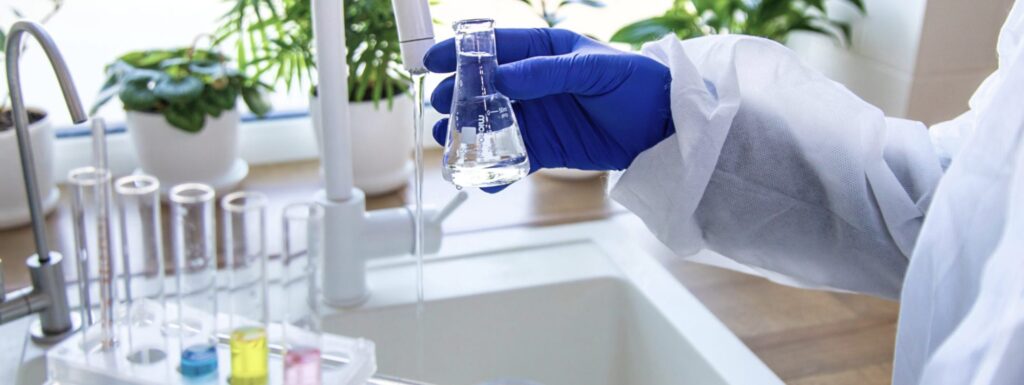Congratulations on your new well! This is a big step towards self-sufficiency and clean water. But remember that well water comes directly from groundwater, which can sometimes have hidden dangers. Not testing your well water is like driving a car blindfolded: you don’t know what you might encounter. Drinking contaminated well water can lead to serious health problems affecting digestion, reproduction, and the nervous system. Regularly testing your well water is essential for your family’s health and safety. Make it a priority to test your new well water right away.
Bacteria Test
This is the most crucial initial test. The presence of coliform bacteria and, more alarmingly, E. coli indicates fecal contamination, often from animal waste or septic system leaks. Ingesting these bacteria can lead to severe gastrointestinal illnesses, especially in young children and the elderly. Seasonal testing tips: While an initial water test is crucial, it’s just the first step. Heavy rainfall, spring thaw, or flooding can introduce new contaminants into your well. That’s why re-testing after major weather events is highly recommended. For hassle-free and certified well water testing, Superior Plumbing & Heating provides comprehensive analysis and clear, expert interpretation of your results.
Nitrates/Nitrites
High levels of nitrates and nitrites are particularly dangerous for infants under six months old, potentially causing “blue baby syndrome” (methemoglobinemia), a condition that reduces the blood’s ability to carry oxygen. Agricultural runoff, fertilizers, and septic systems are common sources of these contaminants. Be especially vigilant if your property is near farmland.
Heavy Metals
Lead and arsenic are two notorious heavy metals that can leach into well water from natural geological deposits or old plumbing. Certain regions in Canada have been identified as hotspots for these contaminants. Long-term exposure can lead to serious neurological problems, kidney damage, and increased cancer risk.
pH Levels
The pH level in your water indicates its acidity or alkalinity. Low pH (acidic water) can cause corrosion of plumbing and fixtures, leading to metals such as lead and copper leaching into your drinking water. High pH (alkaline water), on the other hand, can result in scaling and decreased appliance efficiency. You can use home test kits for basic monitoring, but a lab test offers a more accurate initial reading.
Total Dissolved Solids (TDS)
TDS measures the total amount of dissolved substances in your water, including minerals and salts. High TDS contributes to hard water, which can leave soap scum, dry out skin and hair, and reduce the lifespan of your appliances such as water heaters or dishwashers. While elevated TDS isn’t always a direct health risk, exceeding the recommended threshold may indicate underlying water quality issues that should be addressed.
Radon
Radon is a naturally occurring radioactive gas that can dissolve in groundwater. In certain areas across Canada, the ground may have higher radon levels. Radon can also be present in water and enter the air during everyday activities like showering, increasing the risk of lung cancer.
Pesticides
If your new well is located near farmland or areas where pesticides may have been used, testing for these chemicals is crucial. Cumulative exposure risks to even low levels of certain pesticides can have long-term health consequences.

Signs You Need Emergency Testing
While the initial seven tests offer a solid baseline, any sudden changes in your water’s appearance, smell, or taste should prompt immediate, emergency testing.
Visual/Taste Warnings:
- Yellow or orange water: This often indicates the presence of iron bacteria, which, while not typically a direct health threat, can cause unpleasant tastes, odours, and stains on plumbing fixtures.
- Blue-green stains on faucets and fixtures: This can be a sign of acidic corrosion, meaning your low pH water is leaching copper from your plumbing.
- A noticeable salty taste: This could indicate road salt infiltration, especially if your well is located near roadways treated in winter. High sodium levels can be a health concern for individuals with certain medical conditions.
Health Warnings:
- Multiple family members experiencing recurring diarrhea or vomiting: This is a strong indicator of potential bacterial or viral contamination and requires immediate investigation through water testing.
- Unexplained skin rashes or irritation after showering or bathing: This could be a reaction to elevated levels of certain minerals, chemicals, or bacteria in your well water.
Environmental Impact:
- A nearby chemical spill or industrial accident: If there’s any risk of contaminants leaching into the groundwater near your well, immediate testing is crucial to assess the safety of your water supply. Contact your provincial environmental emergency response line immediately.
- Flooding that has submerged the wellhead: Floodwaters can carry a wide range of contaminants, including sewage, agricultural runoff, and chemicals, directly into your well. Testing is essential after any such event. Follow guidance from your local public health unit regarding well disinfection after flooding.
How To Understand Your Report
Once your water test results are received, you’ll likely see a list of contaminants and their measured levels, often compared to the Canadian Drinking Water Quality Guidelines. Understanding how to read these contaminant levels is important. Pay close attention to whether any parameters exceed the Maximum Acceptable Concentration (MAC).
If there is a small amount of a non-acute contaminant, you should retest the water or use a simple filtration solution. However, if you find E. coli or very high levels of nitrates or heavy metals, you must act quickly and consult a water treatment professional.
Treatment Solutions
If your water test reveals contamination, prompt action is crucial.
Emergency fixes: In cases of bacterial contamination, boiling your water for at least one minute (rolling boil) is a temporary but essential measure to kill harmful microorganisms. Temporary filters, such as those used for camping, can provide a short-term solution for sediment or taste issues, but they are not a substitute for proper treatment. Always follow any boil water advisories issued by your local public health unit.
Permanent systems: The best long-term solution depends on the specific contaminants identified in your test. We at Superior Plumbing & Heating offer a range of tailored solutions, including:
- Whole-house filtration systems: Allow you to purify all water entering your home, providing comprehensive protection.
- Point-of-use filters: Installed at specific taps (e.g., kitchen sink) for drinking and cooking water.
- Water softeners: Remove hard minerals like calcium and magnesium.
- Iron removal filters: Target iron and manganese, preventing staining and taste issues.
- UV light sterilizers: Effectively eliminate bacteria, viruses, and other microorganisms without chemicals.
- Reverse osmosis (RO) systems installation: A highly effective filtration method for removing a wide range of contaminants, including heavy metals, nitrates, and pesticides.
We will analyze your water test results and recommend the most effective and cost-efficient treatment system for your specific needs.
REFERENCES
1. Radon gas: it’s in your home
https://www.canada.ca/en/health-canada/services/environmental-workplace-health/reports-publications/radiation/radon-your-home-health-canada-2009.html
2. Canadian Drinking Water Guidelines
https://www.canada.ca/en/health-canada/services/environmental-workplace-health/water-quality/drinking-water/canadian-drinking-water-guidelines.html



